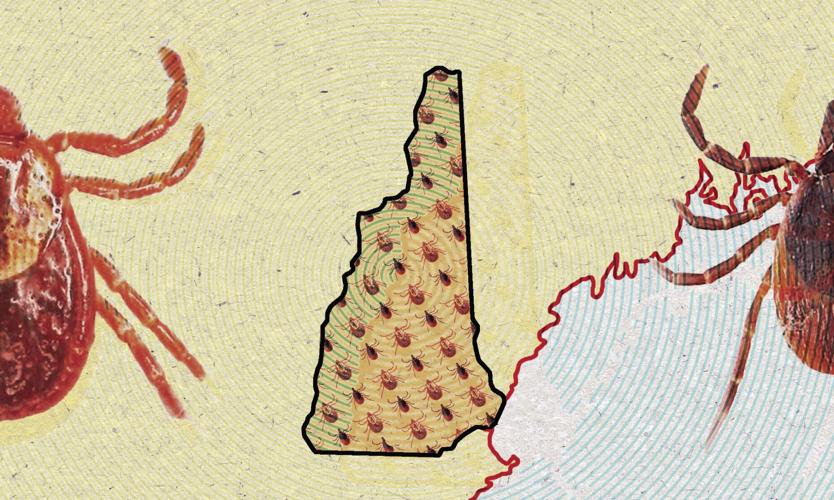As the summer weather beckons people outside, Kaitlyn Morse, founder of a citizen-science organization, warns there is likely something creepy waiting for them to draw near: ticks.
Morse founded Bebop Labs, which started working in 2018 to fill in gaps related to public health information. The first gap investigated was ticks —where are people finding them, what kind of ticks are out there, and what diseases are they carrying? Morse started her research organization in Ashland, inviting people who find a tick to send it in to her, along with information about when, where and how it was found, so she can get test them for pathogens.
Since then, Bebop has received thousands of ticks each year, mostly from across New Hampshire, and has found that while the most common ticks to bite humans are dog ticks, the much smaller blacklegged ticks — sometimes called deer ticks — are the ones most likely to transmit diseases.
What Bebop found is that nearly 40% of the blacklegged ticks they've tested have carried the bacteria that causes Lyme disease. Blacklegged ticks appear in two seasons, and they will likely still be around, and out for blood, at Fourth of July cookouts.
"They're early this year, and came early with a fire," Morse said, describing a high volume of blacklegged ticks arriving in May, which is the start of a three-month stretch of activity for the poppyseed-sized parasites. They typically recede into the debris of the forest floor by August, then are found again in the fall, looking for another meal.
Morse said she isn't surprised to see a high volume of blacklegged ticks this spring, as there was a spike in the small species of ticks in that fall. The winter wasn't harsh enough to knock back their numbers, nor the availability of the rodents they also feed on scarce enough.
June and July can be particularly problematic for Lyme transmission into humans, Morse said. It's when many people seek the outdoors, but it's also when the blacklegged and the dog tick seasons overlap.
"The spring season is one of the hardest seasons for New Hampshire. We are all cabin-fevered out from the winter, it's gardening season, we want to do our exercise," Morse said. "And both species of ticks are out. If you're doing your tick checks, you might see the big ticks and you might miss the little ones... you just have to be conscious that there's two different species of ticks."
"Tick checks," as referred to by Morse, are part of the set of practices suggested for anyone who ventures near the forests and tall grass where ticks await. Other tips include wearing long sleeved shirts and pants, hats, tucking shirts into pants, and pants into sock, wearing light-colored clothing and boots or shoes instead of sandals, and spraying clothes with a permethrin solution.
Morse advocates the use of "tick tubes" for people who live in tick-prone environments. To make a tick tube, spray cotton balls or dryer lint with permethrin, then stuff the fluff into a cardboard tube such as the kind used to hold toilet paper or paper towels. Place the tubes somewhere that rodents can access, then the squirrels, mice and chipmunks will use the material to line their nests, and in doing so, break a chain in the tick life cycle.
Tick-borne diseases
These precautions are necessary, because ticks are known vectors of several diseases. Bebop Labs has detected miyamotoi, anaplasmosis and babesia in ticks it has tested from New Hampshire. But by far, the most prevalent disease is Lyme, caused by the bacteria borrelia.
The good news is that it takes a tick bite that lasts for 24 hours, or maybe longer, for enough of the pathogen to transfer into a human. That's why daily tick checks are an important strategy for people who pass through tick-prone areas.
People are taking their tick bites seriously, according to Dr. Oliver Salmon at Plymouth Pediatric & Adolescent Medicine. He said he has seen "probably more than usual for this time of year, but hard to tell," referring to patients who come in with tick-related concerns. He added he hasn't yet seen more Lyme diagnoses than usual, though those usually take weeks after the initial tick bite to present.
Both Dr. Salmon and Dr. Nancy Quintero, at Speare Primary Care, said that they have been prescribing antibiotics prophylactically — meaning preventatively — when patients report a tick bite that could result in Lyme transmission.
"People are being more diligent in protecting themselves against tick bites and they are making sure they look for ticks before bedtime," said Dr. Quintero.



















(0) comments
Welcome to the discussion.
Log In
Keep it Clean. Please avoid obscene, vulgar, lewd, racist or sexually-oriented language.
PLEASE TURN OFF YOUR CAPS LOCK.
Don't Threaten. Threats of harming another person will not be tolerated.
Be Truthful. Don't knowingly lie about anyone or anything.
Be Nice. No racism, sexism or any sort of -ism that is degrading to another person.
Be Proactive. Use the 'Report' link on each comment to let us know of abusive posts.
Share with Us. We'd love to hear eyewitness accounts, the history behind an article.